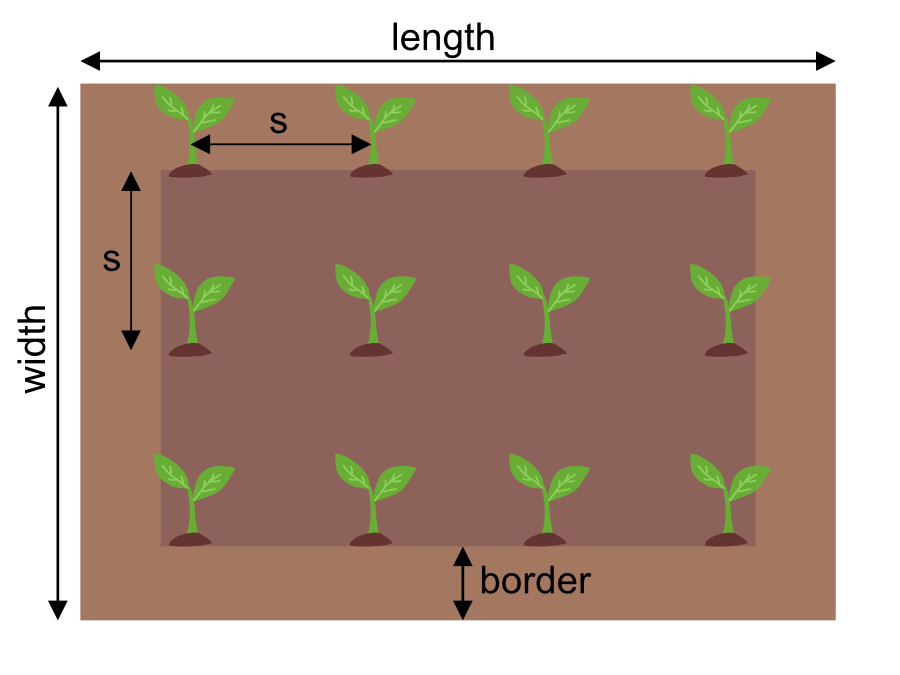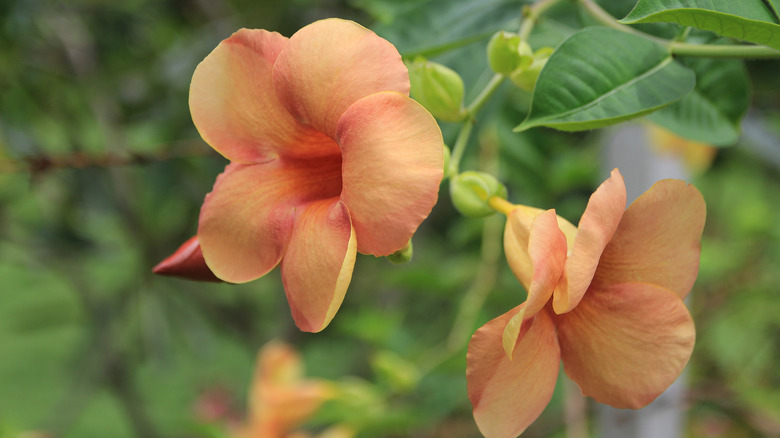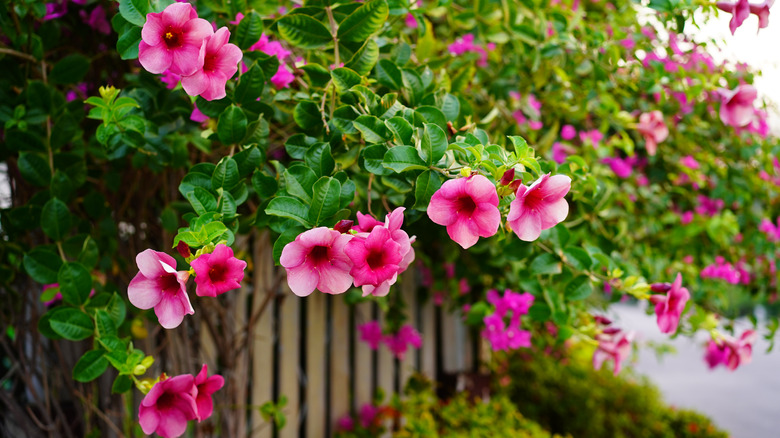Most often referred to as the golden trumpet, Allamanda cathartica is a flowering vine native to Central and South America. It was first described and classified by the great Carl Linnaeus, considered one of the most influential and important botanists in history, as per the University of California, Berkeley. He named this robust flower after Dr. Frédéric-Louis Allamand, a fellow botanist and friend from Switzerland. Bright yellow is the most common color for allamanda flowers, hence the golden nickname, but you can also find the blooms in gorgeous shades of pink and peach.
Kew Royal Botanical Gardens describes the leaves of the allamanda as lance-shaped, meaning they taper from base to tip. Individual leaves tend to grow a few inches long and about 1 inch wide. That size pales compared to the glorious trumpet-shaped blossoms, which can be close to 4 inches long and over 2 inches wide. Each vine of this often mammoth-sized plant has the potential to stretch well over 20 feet high.
Fifteen Allamanda species have been classified so far; the latest discovery occurred in 2009. Even though this happened in Brazil, where the plant is commonly found, research shows that the original introduction of the golden trumpet vine made its way to South America from Africa as many as 20 million years ago. These days, allamandas have spread across the globe and naturalized themselves into many tropical locations, including the rainforests of Queensland, Australia. They are popular in USDA hardiness zones 10 and higher within the United States, where you can find them gracing many a landscape in places like South Florida and much of California.
Alamanda plants, also known as golden trumpets or yellow bells, are absolutely gorgeous tropical shrubs that produce abundant yellow blooms. With shiny green leaves and trumpet-shaped flowers, they make a vibrant statement in any garden. However, to keep your alamanda plants healthy and ensure they reach their full beauty, proper spacing is absolutely essential.
In this article, we’ll explore why spacing matters so much for alamandas and how to space them correctly. We’ll also cover care tips to maintain proper spacing ongoing. Get ready to learn the secrets to creating a stunning alamanda garden!
Why Proper Spacing Matters
Giving your alamanda plants enough space makes all the difference. When plants are overcrowded, they compete for sunlight, water, and nutrients. This leads to weak, stunted growth and greater susceptibility to diseases.
Adequate spacing allows air to circulate freely around the plants, preventing fungal infections that thrive in humid, still conditions. It also reduces pest problems by limiting their ability to jump from plant to plant
Visually, proper spacing creates an appealing look with each plant having room to reach its full size. An overcrowded alamanda garden ends up with tangled, overlapping plants that look messy rather than beautiful.
How Much Space Between Alamanda Plants?
Since alamanda plants grow up to 6-8 feet tall and spread out 4-6 feet wide each plant needs adequate room to reach maturity without encroaching on its neighbors.
Here are the recommended alamanda spacing guidelines:
-
Space plants at least 3-4 feet apart for proper growth.
-
Allow 1-2 feet between plants and any walls, fences or structures.
-
For small gardens, plant 1-2 alamandas rather than crowding in too many.
-
Give plants along a border more space since they’ll spread outward.
-
Plant smaller varieties like ‘Thalia’ closer together.
Take the alamanda’s expected mature size into account when planning spacing. This ensures your plants won’t outgrow their allotted areas.
Design Tips for Proper Alamanda Spacing
When incorporating alamandas into your landscape design, keep these spacing tips in mind:
-
Use alamandas as stand-alone feature plants for maximum impact.
-
Space them throughout beds and borders as focal points.
-
Edge a pathway or driveway with evenly spaced alamandas.
-
Plant them on either side of entryways or along fences.
-
Place containers with alamandas on patios, allowing plenty of space.
-
Underplant alamandas with lower-growing plants like vinca.
-
Mix with other tropical plants like hibiscus that share spacing needs.
Maintaining Proper Spacing Long-Term
Planting alamandas far enough apart is just the beginning. You’ll also need to maintain proper spacing over time through:
-
Regular pruning: Trim overgrown branches and foliage to prevent crowding.
-
Timely fertilizing: Feed plants balanced fertilizer to support healthy growth within their space.
-
Occasional division: Dig up overgrown clumps and replant divisions for rejuvenation.
-
Prompt removal of dead plants: Replace any that die to keep desired spacing.
With attention to spacing maintenance, your alamanda garden will stay lush and beautiful for years to come.
Common Alamanda Care Tips
To keep your properly spaced alamandas growing strong, remember these care essentials:
-
Water 1-2 times per week, allowing soil to partially dry out between waterings.
-
Provide at least 6 hours of sunlight daily.
-
Use well-draining soil enriched with compost.
-
Watch for pests like mealybugs and treat promptly.
-
Apply balanced fertilizer monthly during spring and summer.
-
Prune back spent flower stems to encourage reblooming.
-
Bring potted alamandas indoors before first frost in fall.
Enjoy Your Thriving Alamanda Garden!
Spacing your alamandas properly from the start prevents overcrowding and encourages healthy, vigorous growth. Combined with attentive care, attractive design, and maintenance pruning, you can enjoy a beautiful alamanda garden that delights the eye.
No more tangled, competing plants or struggling blooms. Just vivid green foliage and cascading yellow trumpet flowers. With adequate spacing, your alamandas will flourish and add a dramatic tropical vibe to your landscape!

Flowering allamanda vine varieties

Bright yellow flowers adorn the standard Allamanda cathartica vine. Per VerdeGo Landscaping, among these golden trumpets, there are at least four plant varieties, each with a slightly different shape. Allamanda brown bud has an orange button at the center of its yellow flowers. The allamanda bush will maintain a shrub-like form with a maximum height and width of 6 feet and 4 feet, respectively. Dwarf Allamanda (Allamanda cathartica compacta) stays smaller still, maxing out at 3 feet high and 3 feet wide. These can be used as border plants or to create a low-lying hedge. Lastly, the golden butterfly will give you the most aggressive climbing capabilities of them all.
Apart from the golden trumpets, there are other beautiful creations to consider for your garden.
- Peaches and Cream (Allamanda Peach mianaus) offers stunning two-toned flower petals that radiate from a dark center and fluctuate between warm oranges and pale cream tones.
- Allamanda Blanca (Allamanda alba) gives you a rare opportunity to own a white flowering allamanda. This one is also called the white trumpet.
- Purple Allamanda (Allamanda blanchetii) is not exactly purple despite its common name. Instead, it can be found in various shades of pale and bright pinks, rosy blush tones, and violets.
- Cherry Allamanda (Allamanda Cherries Jubilee) is another two-toned variety. The flower petals of this stunner vacillate between pale pink and a near-fuchsia hue.
- Mini Red Cabernet Allamanda (Allamanda x violacea Cabernet) is the way to go if you like a true red, almost burgundy-toned flower. Botanists brought together the bush and vining varieties to create this mini hybrid, which is notated by the x in its name. Unlike many of the others, the mini red cabernet can be easily maintained in a container. Golden trumpet lovers will love this type because it can be given as a gift that will not overwhelm its receiver as the others may.
How to care for a flowering allamanda vine

Once youve got your plants good and growing — and youve decided how and where you want to use them in your landscape — its time to get them into the ground and give them their best chance at success. Your climate zone will decide whether they will grow year-round (USDA hardiness zone 10 and higher) or make beautiful summer annuals that you can either overwinter inside a greenhouse or simply let go at the end of the season.
According to the University of Wisconsin-Madisons Horticulture Division, growing allamanda plants need both moist and well-draining soil and full sun exposure, as you already know. Be sure to plant them in a spot that will receive a minimum daily allotment of four hours of direct sun; the more sunlight, the better when it comes to flower production. Dig a hole bigger than the grow pot and line it with a layer of nutrient-rich garden soil. Gently tip your plant over and tap the bottom of the pot to release the entire root ball. Move carefully to keep everything intact as you place the plant in its new home. Backfill with more garden soil and tamp down just a touch to make sure youve covered it with enough dirt to secure it into place.
Water your vines regularly through the summer months, never letting the soil completely dry out. Provided the soil is truly well-draining, you should not have any problems with standing water. Remember to give your vines structural support and opportunities for attachment as they grow.
Plant Spacing Secrets (& how to balance your landscape)
FAQ
How far apart should you plant allamanda?
What is the spacing for allamanda?
Where is the best place to plant allamanda?
How tall and spread is allamanda?
How to plant Alamandas?
Before planting the alamandas in your yard, garden, vegetable garden, or terrarium, make sure that the soil is at least 70 centimeters deep. Also provide supports or stakes for the branches of the vine if it is not to be planted near walls, pergolas, fences, or the like.
How do you propagate Alamanda?
This is the most common method of propagating Alamanda plants. Follow these steps: Choose a healthy branch with 3-4 nodes (where the leaves are attached to the stem). Cut the branch at a 45-degree angle using a sharp, clean pair of scissors or pruning shears. Remove the leaves from the bottom two nodes.
Is Alamanda a good plant?
This beautiful plant produces vibrant yellow flowers that bloom in clusters, making it a popular choice for gardens and indoor spaces alike. However, like all plants, alamanda requires proper care and attention to ensure healthy growth.
How do you care for an Alamanda plant?
In conclusion, caring for an alamanda plant requires attention to its light requirements, watering schedule, soil conditions, fertilizer needs, pruning techniques, and pest prevention measures. By following these tips and tricks outlined in this article, you can help ensure that your alamanda thrives and produces beautiful blooms year after year.
